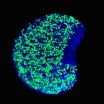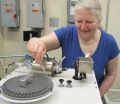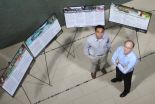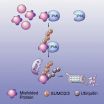(Press-News.org) Baltimore, MD— A woman's supply of eggs is a precious commodity because only a few hundred mature eggs can be produced throughout her lifetime and each must be as free as possible from genetic damage. Part of egg production involves a winnowing of the egg supply during fetal development, childhood and into adulthood down from a large starting pool. New research by Carnegie's Alex Bortvin and postdoctoral fellow Safia Malki have gained new insights into the earliest stages of egg selection, which may have broad implications for women's health and fertility. The work is reported in the early on-line edition of Developmental Cell.
The most stringent egg selection takes place at the earliest stages. Even before a baby girl is born, she has already lost 80 percent of her initial pool of immature eggs during fetal development. This phenomenon has been observed in primates and rodents, as well as some invertebrates, which indicates that it has been around for a long time evolutionarily speaking. But despite its ancient origins, little is understood about how these decisions are being made.
Bortvin's team discovered that the fetal egg die-off is connected to segments of the egg's DNA known as transposable elements or "jumping genes." As developing eggs gain the ability to guide embryo development, transposons gain the ability to start moving. These ancient virus-like genes begin to leapfrog around the egg's DNA, thereby producing new mutations, just as transposon movement causes color mutations in ears of corn. A transposable element named LINE1 is the most likely to become activated in mammalian eggs.
Jumping genes can be particularly destructive in sperm and eggs, since much of their genetic material is an essential part of the recipe for developing a healthy baby. Think of the genome of an egg or sperm as a stack of papers being photocopied. In order to be read and understood, they have to come out of the copier in the same order they went into it. But jumping genes are like pages that insert themselves at random into the stack, making the reading process difficult or even impossible.
Prior studies by Bortvin and others showed that male germ cells quash the movement of transposons, minimizing mutations and ensuring high levels of sperm production. In contrast, Bortvin and Malki discovered that female mice allow transposon movement to take place, but then get rid off immature eggs harboring the highest number of mutations before the female mouse is even born. The team proposes that this purging process allows for the selective survival of immature eggs whose genetic material has acquired relatively few new mutations.
Bortvin's group also discovered that the process of immature egg purging must be finely balanced. Overly stringent surveillance could result in excessive egg purging, too few surviving eggs, and premature loss of fertility. Surveillance that is not stringent enough, on the other hand, would allow eggs with a lot of jumping gene-related errors to survive, and lead to a high level of birth defects, such as those caused by an incorrect number of chromosomes in the offspring.
"Our findings suggest that the ovary of a newborn girl already contains both 'good' eggs and those destined to give rise to Down syndrome or miscarriages," Bortvin said. "Further study may show that these 'good' cells are ovulated first and the abnormal ones usually come later."
Importantly, Bortvin and Malki discovered that a drug AZT, which inhibits multiplication of AIDS-causing HIV virus in humans, also alters jumping gene activity in immature eggs. In particular, it is effective against LINE1 transposons. This discovery raises the possibility that the number and quality of immature eggs might be enhanced by drug treatment.
Finally, Bortvin and Malki's work raises the question of whether this immature egg purge is actually a blessing in disguise. Despite their destructive power, jumping genes are also the source of serendipitous genetic novelty that can make species stronger and better suited for survival over time. By allowing just the right amount of beneficial transposon-generated genetic variation, female mammals are giving their offspring and species the best chance of thriving in an uncertain, dangerous world.
INFORMATION:
This work was supported by the endowment of Carnegie Institution for Science, by a CPRIT R1101 award, and by NIH grant GM40367. Researchers were supported by an EMBO long-term fellowship and a McClintock fellowship as well as a Hollaender fellowship.
The Carnegie Institution for Science is a private, nonprofit organization headquartered in Washington, D.C., with six research departments throughout the U.S. Since its founding in 1902, the Carnegie Institution has been a pioneering force in basic scientific research. Carnegie scientists are leaders in plant biology, developmental biology, astronomy, materials science, global ecology, and Earth and planetary science.
Fertility: Sacrificing eggs for the greater good
2014-05-29
ELSE PRESS RELEASES FROM THIS DATE:
NASA missions let scientists see moon's dancing tide from orbit
2014-05-29
Scientists combined observations from two NASA missions to check out the moon's lopsided shape and how it changes under Earth's sway – a response not seen from orbit before.
The team drew on studies by NASA's Lunar Reconnaissance Orbiter, which has been investigating the moon since 2009, and by NASA's Gravity Recovery and Interior Laboratory, or GRAIL, mission. Because orbiting spacecraft gathered the data, the scientists were able to take the entire moon into account, not just the side that can be observed from Earth.
"The deformation of the moon due to Earth's pull ...
UNL team explores new approach to HIV vaccine
2014-05-29
Lincoln, Neb., May 29, 2014 -- Using a genetically modified form of the HIV virus, a team of University of Nebraska-Lincoln scientists has developed a promising new approach that could someday lead to a more effective HIV vaccine.
The team, led by chemist Jiantao Guo, virologist Qingsheng Li and synthetic biologist Wei Niu, has successfully tested the novel approach for vaccine development in vitro and has published findings in the international edition of the German journal Angewandte Chemie.
With the new approach, the UNL team is able to use an attenuated -- or weakened ...
A tool to better screen and treat aneurysm patients
2014-05-29
New research by an international consortium, including a researcher from Lawrence Livermore National Laboratory, may help physicians better understand the chronological development of a brain aneurysm.
Using radiocarbon dating to date samples of ruptured and unruptured cerebral aneurysm (CA) tissue, the team, led by neurosurgeon Nima Etminan, found that the main structural constituent and protein – collagen type I – in cerebral aneurysms is distinctly younger than once thought.
The new research helps identify patients more likely to suffer from an aneurysm and embark ...
Gender stereotypes keep women in the out-group
2014-05-29
New Rochelle, NY, May 29, 2014—Women have accounted for half the students in U.S. medical schools for nearly two decades, but as professors, deans, and department chairs in medical schools their numbers still lag far behind those of men. Why long-held gender stereotypes are keeping women from achieving career advancement in academic medicine and what can be done to change the institutional culture are explored in an article in Journal of Women's Health, a peer-reviewed publication from Mary Ann Liebert, Inc., publishers. The article is available free on the Journal of Women's ...
Caught by a hair
2014-05-29
Crime fighters could have a new tool at their disposal following promising research by Queen's professor Diane Beauchemin.
Dr. Beauchemin (Chemistry) and student Lily Huang (MSc'15) have developed a cutting-edge technique to identify human hair. Their test is quicker than DNA analysis techniques currently used by law enforcement. Early sample testing at Queen's produced a 100 per cent success rate.
"My first paper and foray into forensic chemistry was developing a method of identifying paint that could help solve hit and run cases," explains Dr. Beauchemin. "Last year, ...
Neural transplant reduces absence epilepsy seizures in mice
2014-05-29
New research from North Carolina State University pinpoints the areas of the cerebral cortex that are affected in mice with absence epilepsy and shows that transplanting embryonic neural cells into these areas can alleviate symptoms of the disease by reducing seizure activity. The work may help identify the areas of the human brain affected in absence epilepsy and lead to new therapies for sufferers.
Absence epilepsy primarily affects children. These seizures differ from "clonic-tonic" seizures in that they don't cause muscle spasms; rather, patients "zone out" or stare ...
Drop in global malnutrition depends on ag productivity, climate change
2014-05-29
WEST LAFAYETTE, Ind. - Global malnutrition could fall 84 percent by the year 2050 as incomes in developing countries grow - but only if agricultural productivity continues to improve and climate change does not severely damage agriculture, Purdue University researchers say.
"The prevalence and severity of global malnutrition could drop significantly by 2050, particularly in the poorest regions of the world," said Thomas Hertel, Distinguished Professor of Agricultural Economics. "But if productivity does not grow, global malnutrition will worsen even if incomes increase. ...
Penn study shows how misfolded proteins are selected for disposal
2014-05-29
PHILADELPHIA – It's almost axiomatic that misfolded proteins compromise how cells normally function and cause debilitating human disease, but how these proteins are detected and degraded within the body is not well understood. Neurodegenerative diseases – including Alzheimer's disease, Parkinson's disease, amyotrophic lateral sclerosis (Lou Gehrig's disease), Huntington's disease, and spinocerebellar ataxias – exact a devastating toll on aging populations throughout the world.
"Yet, there is virtually no cure for any of these diseases, and clinical trials have yielded ...
Tropical Storm Amanda gets bisected and animated by NASA's CloudSat
2014-05-29
VIDEO:
This animation shows how Cloudsat was able to get the image shown.
Click here for more information.
Tropical Storm Amanda continues to weaken in the eastern Pacific from dry air and wind shear. NASA's CloudSat satellite captured a view of the storm from the side revealing heavy precipitation when the storm was the most powerful May Eastern Pacific on record.
NASA's CloudSat satellite flew over Hurricane Amanda in the east Pacific on May 25, 2014 at 2100 UTC (5 p.m. EDT) ...
An ecological risk research agenda for synthetic biology
2014-05-29
Washington — Environmental scientists and synthetic biologists have for the first time developed a set of key research areas to study the potential ecological impacts of synthetic biology, a field that could push beyond incremental changes to create organisms that transcend common evolutionary pathways.
The Synthetic Biology Project at the Wilson Center and the Program on Emerging Technologies at the Massachusetts Institute of Technology convened the interdisciplinary group of scientists and are releasing the report, Creating a Research Agenda for the Ecological Implications ...






